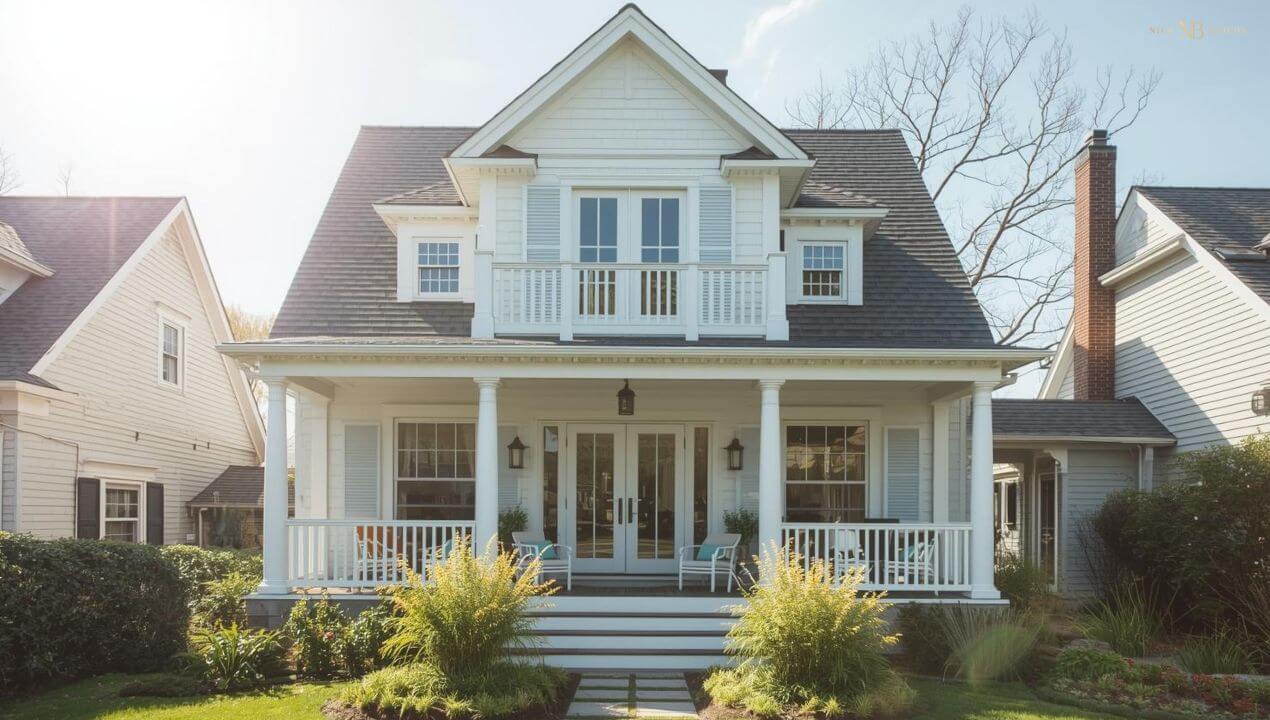While often overlooked, ceiling heights significantly transform the entire feel of a home; the type you choose is essential to ensure your dream home doesn’t replicate a haunting echo chamber or a claustrophobic mouse trap.
Apart from the look of your home, ceilings also impact the atmosphere. The area, ventilation and insulation that support your space are crucial to ensure the overall livability and safety; ceilings directly influence each of these. The height of your roof further determines what facilities or features you can add.
If you’re building a home and expect to confirm the height of your ceiling or need substantial input on a design, contacting a building certifier is vital. Australia’s construction code specifies minimum ceiling heights, essential for all builders and homeowners, to improve the functionality and maintain the property value of their home.
Legal policies for standard ceiling height in Australia
The National Construction Code (NCC), which oversees sustainable and legal construction of homes in Australia, has a set of guidelines that highlight the standard ceiling height in Australia. Some constructors make adjustments based on preference, but overall, the rules set a benchmark.
According to the NCC, the minimum ceiling height of 2.4 metres for habitable rooms such as bedrooms and living rooms, 2.1 metres for non-habitable rooms, and at least 2.0 metres for areas like staircases and ramps is appropriate.
Although the standards remain the same, modifications are made in accordance with state and local building codes, which may involve obtaining necessary permits and collaborating with licensed professionals, such as builders and architects.
Why is it important to reach the minimum ceiling height requirement in Australia?
Rules are put in place for a reason, and maximum value can be achieved when regulations are followed. Ceiling Height requirements shape not just the appearance of the home but also the interior stability.
The average ceiling height in Australia has increased to around 2.7m; the standard is not set in stone, and various home builders and homeowners have made changes to suit their personal and design preferences.
The impact of ceiling height goes beyond comfort; having a standard ceiling can not only boost the value of your home but also enhance functionality. If done correctly, low ceilings prove ideal for a comfortable and intimate feel, while high ceilings give an illusion of luxury and space. This is where standards come in. The NCC standards build a framework for you to start with, almost like a guide.
Functionality runs hand in hand with convenience. To decide on a particular ceiling type or height, it is essential to first picture the inclusions and intention. Will you add more elevated furniture to your home, or are you opting for a minimalistic set? It also comes down to the vibe you want for your room, whether you want it to feel comfy or lavish.
If you’re planning to rebuild or renovate your home, ceiling types need to be specified accordingly. For rebuilds, ceilings can be dynamic and adjusted as preferred; however, they need to follow the policy standards.
Lastly, another essential factor is safety, which is often disregarded. Lower ceilings can be confining if not designed properly. Insulations at home need proper adjustment, overhead lighting, lamps or chandeliers need to be correctly positioned, and ceilings need to be designed with these images in mind.
Ventilation is another essential factor. High ceilings provide ample room for natural lighting and air circulation, confirming that crucial areas of the home or the overall home itself is not restricted is important.
As important as it is to be aware of the ceiling height requirement, it is equally crucial to understand the home construction process. Learn more about the stages in building a house in Australia.
Benefits of High and Low Ceilings in Australian Homes
Ceiling types concerning height are divided into two: high and low. According to personal preference, you could opt for either a high ceiling or a low one. However, it isn’t just personal preference that impacts the choice, but also the type of your home, the area you’re building in, and the standard requirement for ceiling height in your state.
Choosing ceiling height directly affects homes or apartments and how they’re perceived daily, not just by visitors but also by residents. Lately in Australia, high ceilings are in; there has been an increasing trend of replicating sanctuaries for homes, luxury quarters that have a larger-than-life feel to them. However, both types of ceilings have their own benefits; picking accordingly is crucial.
Benefits of High Ceilings
Sense of grandeur: High ceilings are an increasing trend among Australians and a desirable feature in homes. Higher ceilings make homes appear spacious and elegant. They add an aesthetic to the living space, giving it a modern touch.
Natural Light and Ventilation: A Higher ceiling means more room. If the ceilings are taller, the windows can be larger, meaning more natural light and ventilation. The home will feel fresh and active.
Spacious feel: The higher the ceiling, the larger the home feels. It constructs a certain illusion that makes the room feel bigger. It also allows for larger and taller furniture and windows, thus contributing to the look.
Increased property value: Since higher ceilings are a trend, they also have a great market return. Such homes are more desirable and have a loftier property value due to the demand. Especially with timeless home designs like Hampton style homes, high ceilings appear luxurious and attract potential buyers.
Benefits of Low Ceilings
Cost-efficient: High ceilings require more materials, thus inducing a fuller budget; however, with low ceilings, the raw materials used are less in quantity and reasonable, and the overall building and maintenance costs are also affordable.
Less building time: Construction for low ceilings is less taxing than for high ceilings. With taller ceiling designs, work can be a chore and require more materials; low ceilings are equally methodical, but in comparison, construction time is shorter.
Sense of comfort: Low ceilings foster a cosy ambience, your home presents an additionally welcoming and warm atmosphere, and it’s great if you’re someone who prefers comfortable and smaller spaces.
Types of Ceiling Design
Beyond height, ceilings are split based on the designs and materials used. Designs completely change the outlook of your home. The height of your ceiling is parallel to the design of your roof. For example, a shorter ceiling with a coffered design can be overwhelming, while in taller ceilings, plain roofs don’t add much character. Understanding the difference and picking accordingly is crucial.
Flat Ceiling
These types of ceilings are clean and simple; they’re easy to decorate, and adding accessories is also manageable. If you wish to incorporate bulkheads, flat ceilings are flexible to work on. Flat ceilings are most common in homes across Australia. They’re made from plasterboard material fixed to timber or metal framing.
Raked Ceiling
These types of ceilings are popular in modern, coastal and renovated homes. The finishing is done with materials like timber, exposed beams or plasterboard. It has a sloped ceiling that tracks the pitch of the roof.
Read: Best Suburbs to live in Brisbane.
Coffered ceiling
Coffered ceilings are architecturally and artistically rich. They’re more common in upmarket homes and classic style interiors. Usually features a grid of open panels. They’re not just elegant but also practical, providing sound absorption benefits.
Exposed Beam ceiling
These types of ceilings are primarily designed for raked or vaulted roofs and are popular in rural, industrial or agrarian homes. They use materials like natural timber and faux beams. The strategically placed shafts make rooms appear spacious, while complementing the urban-chic aesthetic.
Tray Ceiling
An extended central section with a raised border, also known as a recessed ceiling, imitates an upside-down tray, thus the name. Common in living rooms and master bedrooms of modern homes. These ceilings are great for integrating direct lighting.
How to choose the right ceiling height in Australia?
Choosing the right ceiling for homes is all about balancing aesthetic preferences, comparing climate zones, and home finances while staying within the building codes set out by the NCC.
Abide by the legal standard ceiling height in Australia
As mentioned, the regulations are not definitive; however, they establish a system that helps build your ideal home. Having these prototypes guides to create sounder home sketches and build a comfortable and safe residence.
Nice Builds, a trusted home builder based in Brisbane, offers spacious home designs with an elevated ceiling height of up to 2.59m. Aligning reasonably with the rules while meeting the standards for the comfortable home you deserve.
Consider your climate zone
Considering your climate zone is essential to ensure that your home designs are made functional and actually habitable. In hot climates, having lower ceilings might be sweltering and not ideal.
Areas like Darwin and Northern QLD are locations where high ceilings are the better choice for natural ventilation, since tall roofs encourage large windows and ceiling fans. While for cooler climates, cosy lower ceilings make heating more efficient.
Building and Maintenance Budget
Considering and making decisions according to your budget is the first rule. Not just at the time of building but also when maintenance is imminent in the later days, such capital considerations need to be made.
Higher ceilings cost more for maintenance in later years, whereas lower ceilings are cost-effective, and renovations and maintenance are also manageable. The cost of building homes can be overwhelming if not managed properly; budgeting is essential.
Compare ceiling features and finishes
The type of ceiling you pick and the materials used in the making of that particular ceiling can dramatically affect the outlook of your home. If you choose a rich roof design, bold mouldings, and coffered panels, it’s likely that for a lower ceiling, the extravagance might feel cramped or overwhelming.
Such luxurious additions draw the eyes upward and add a hefty visual weight, posing a sense of luxury that’s perfect for higher ceilings. Intricate designs shine in rooms with taller ceilings without dominating the look of your home.
Style and safety
Aesthetics are all the rage in the modern day, and the overall style of your home plays a key role in how it’s perceived by visitors. It is necessary to ensure your home design aligns with the ceiling height, for taller furnishings and extravagant decor, a high ceiling is complementary.
Safety is another crucial factor. All inclusions in your home need to be considered when planning ceiling features. Practicality is key; installing large ceiling fans, chandeliers, and pendant lights on a low ceiling is close to inviting disaster. These design elements require optimum vertical clearance to look proportionate and ensure proper function.
To protect your ceilings from water leakage and pest infestations, explore options on roof eaves for your home to elevate your style while also playing safe.
As exciting a journey as it is, building a new home can be just as taxing. Among various considerations, ceilings are essentially ones that homeowners often overlook. They don’t simply elevate the look of your home but also contribute to functionality.
The average height guideline can help draw an initial sketch of how one can begin and understand the options available, and make choices that best reflect your personal preferences.
At Nice Builds, your decade-old home builder based in Brisbane, you can get in touch with experienced professionals who can help guide you from the top to the bottom of your home-building journey.
FAQs
Are 2.7m ceilings high?
Yes, 2.7m ceilings fall under the high ceilings category. The average Australian standard for ceilings is 2.4m. If you need a larger, airier feel to the home, then a 2.7m high ceiling is a better choice.
What is the legal ceiling height in Qld?
In Queensland, the legal height for a ceiling is 2.4m in habitable, common rooms, whereas for non-habitable rooms it’s 2.1m, a height of around 2.0m is essential for staircases and ramps and the lowest point on any ceiling. However, certain minor reformations can be made according to personal preference.
How much does it cost to raise a ceiling in Australia?
Various factors affect the costs when raising a ceiling — the type of home, project scope, roof design, labour and location. However, the approximate cost to raise a ceiling in Australia can range from $1,500 for minor remodelling of a small room to potentially $20,000 or more for a complex raked or vaulted ceiling.
What happens if you don’t meet the standard height for the ceiling in Australia?
If the height of a ceiling significantly differs from the NCC-provided guideline for the standard height of ceilings in Australia, the property’s resale value could decrease substantially. There could be potential legal and practical repercussions. Your home could fail the final inspection, not obtain the building contract, or worse, be forced to rebuild or undergo modifications.






